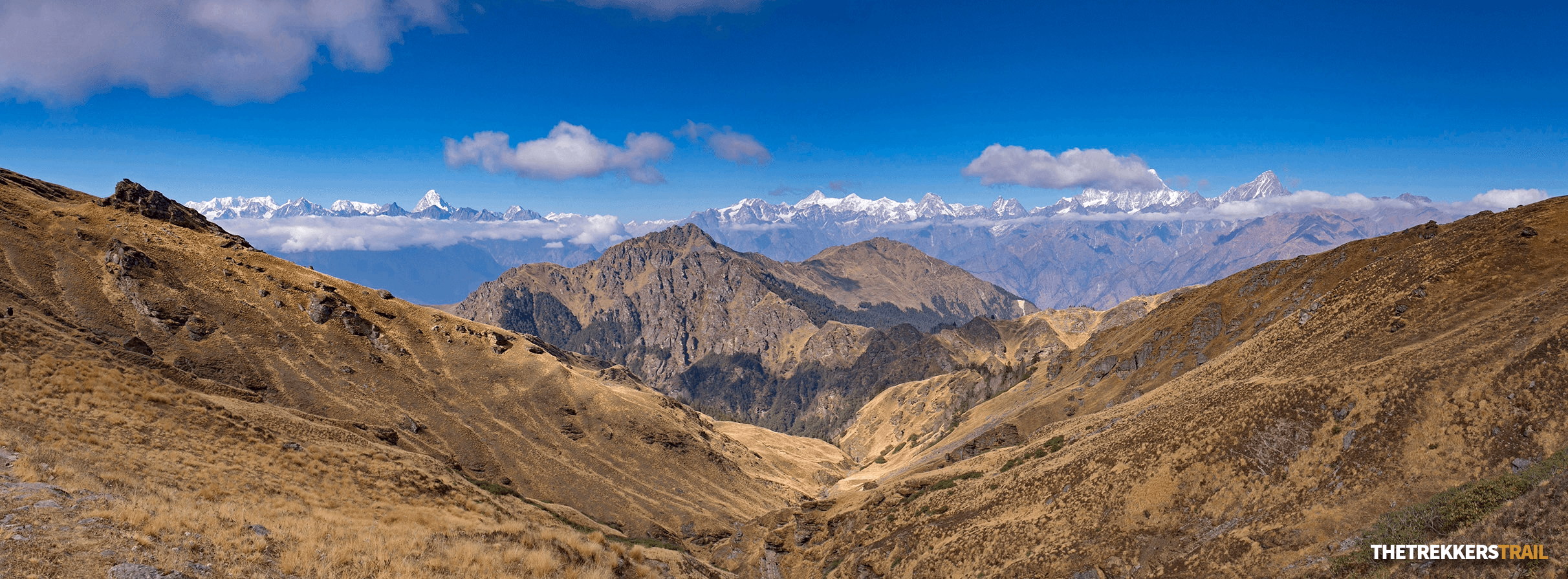The Kuari Pass Trek, nestled in the heart of Uttarakhand, India, is a mesmerizing journey that offers trekkers an intimate encounter with the grandeur of the Himalayas. This trek, renowned for its panoramic vistas and diverse landscapes, provides a unique opportunity to witness some of the most majestic peaks in the region. Among the numerous summits visible, seven stand out prominently: Nanda Devi, Hathi Ghoda, Dunagiri, Mt. Nilkantha, Pangarchulla, Chaukhamba, and Kamet.
1. Nanda Devi (7,817 meters)

As the highest peak entirely within India, Nanda Devi holds a place of reverence both geographically and culturally. Its name translates to “Bliss-Giving Goddess,” reflecting its sacred status among local communities. The Nanda Devi National Park, a UNESCO World Heritage Site, surrounds the peak, preserving its unique biodiversity. Trekkers on the Kuari Pass route are treated to awe-inspiring views of this majestic mountain, especially during clear mornings when the first light illuminates its snow-clad summit.
2. Hathi Ghoda Peaks

These twin summits derive their names from their resemblance to an elephant (Hathi) and a horse (Ghoda). Their unique shapes make them easily identifiable landmarks along the trek. Rising prominently against the skyline, they add a distinctive charm to the panoramic vistas, offering trekkers memorable photographic opportunities and a deeper appreciation for the natural artistry of the Himalayas.
3. Dunagiri (7,066 meters)

Dunagiri, often referred to as Dronagiri, is steeped in mythological significance. According to the Indian epic Ramayana, Lord Hanuman lifted a part of this mountain to obtain the life-saving Sanjeevani herb. Beyond its mythological allure, Dunagiri captivates trekkers with its imposing presence and the rugged beauty of its slopes, serving as a constant companion throughout various segments of the Kuari Pass Trek.
4. Mt. Nilkantha (6,500 meters)

Often dubbed the “Garhwal Queen,” Mt. Nilkantha is renowned for its striking pyramid-like shape. Positioned near the holy town of Badrinath, it holds religious significance and is a favored subject among photographers and mountaineers. Its sharp, snow-covered peak contrasts beautifully against the azure sky, making it one of the most picturesque mountains visible from the Kuari Pass trail.
5. Pangarchulla Peak (4,590 meters)

While not as towering as some of its neighbors, Pangarchulla offers a challenging summit for trekkers seeking an exhilarating climb. The peak is characterized by rocky terrains and, during certain seasons, heavy snow, making the ascent both demanding and rewarding. Reaching its summit provides a 360-degree panoramic view of the surrounding Himalayan giants, offering a profound sense of accomplishment.
6. Chaukhamba (7,138 meters)

Meaning “Four Pillars,” Chaukhamba is a massif comprising four distinct peaks. Dominating the eastern horizon of the Garhwal region, it plays a pivotal role in the local climate and hydrology, feeding several glaciers and rivers. Its expansive snowfields and towering presence make it a focal point of the Himalayan skyline, captivating trekkers with its sheer grandeur.
7. Kamet (7,756 meters)

As the second-highest peak in the Garhwal region, Kamet is often shrouded in mystery due to its remote location. Its towering stature and the formidable glaciers surrounding it have made it a challenging endeavor for mountaineers. From the Kuari Pass, trekkers can admire Kamet’s distant, majestic silhouette, standing as a testament to the enduring allure and challenge of the Himalayas.
Suggested Image: The distant silhouette of Kamet peak under a clear sky, with its glaciers shimmering in the sunlight.
The Kuari Pass Trek Experience
Beyond the visual feast of these seven peaks, the Kuari Pass Trek offers a rich tapestry of experiences. Trekkers traverse through ancient oak and rhododendron forests, cross expansive meadows (locally known as ‘Bugyals’), and encounter quaint Himalayan villages that offer a glimpse into the local culture and traditions. The trail, accessible to both novice and experienced trekkers, provides varying terrains that keep the journey engaging and rewarding.
Best Time to Trek
The ideal periods to undertake the Kuari Pass Trek are during the pre-monsoon months (April to June) and the post-monsoon months (September to November). During these times, the weather remains relatively stable, the skies clear, and the landscapes vibrant, ensuring trekkers can fully immerse themselves in the natural beauty and panoramic views the trail offers.

